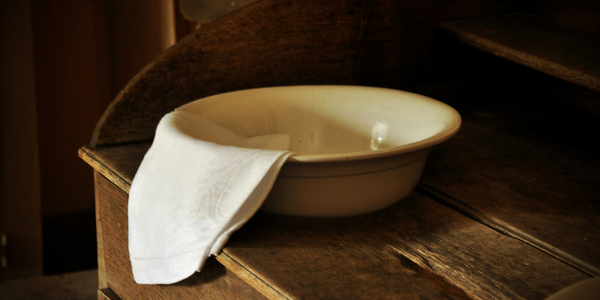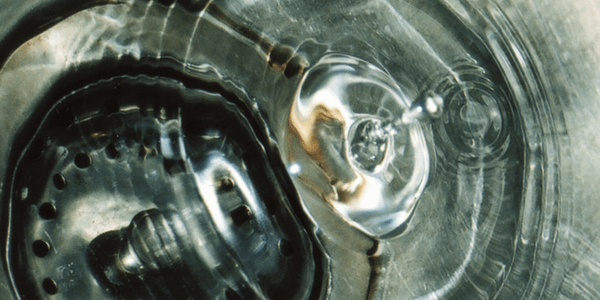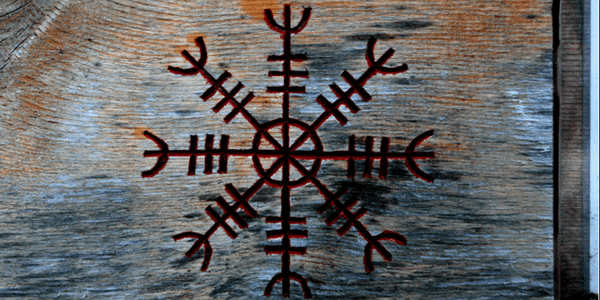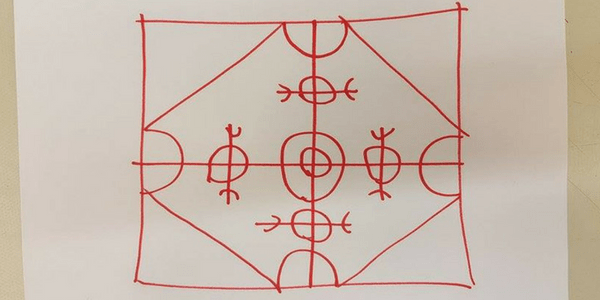
After the Middle Ages, there appeared in Iceland a manuscript tradition which dealt especially with so-called magical spells. All kinds of spells were gathered, usually accompanied by symbols, generally known as galdrastafir. In this article we will discuss one particular spell from this historic grimoire tradition, known as the Washing Verse. It appears many times in many different grimoires, accompanied by a well-known symbol, the Aegishjalmur.
The Washing Verse is a very hands-on spell from this tradition. The name is found as the title of a spell in the Stockholm manuscript ATA, Amb 2, F 16:26. This particular grimoire is called Isländska Svartkonstboken, which translates to the “Icelandic Book of Black Arts,” but has been titled by translator Stephen Flowers as The Galdrabók, and has generally been known as such since.1 Spell 25 in this manuscript is called þvóttar vers, that is “Washing Verse.” Þvóttar or þvóttur derives from the Icelandic verb þvá, “to wash.” The first half line of the prayer serves as a heading. More spells in this and other manuscripts may well be placed in the same category, as will be seen, although sometimes the heading or intention differs.
The main intention behind the Washing Verse is protection. The act of washing is used to remove all the negative projections that people cast on you. It therefore adopts a quality of purification. Nowadays we would reformulate the intention as a cleansing of the aura. More elaborate versions of this spell also include blessing formulas.

Structure
The setup of the Washing Verse consists of two parts. First, the actual washing, and the application of the Aegishjalmur, a symbol translated as the “Helm of Awe” which is explained below. Both parts go with a standard spoken formula.
The whole operation makes use of a basin, which had to be inscribed with the Aegishjalmur. Such basins were commonplace household items in those times and usually made of wood. The Icelandic word for them is mundlaug, which is why the symbol inscribed is sometimes called Mundlaugstafur. Nowadays, we would naturally make use of the tap.
The basic formula of the Washing Verse is found in the Galdramyndir section of Jón Árnason’s writings.2 I quote here the relevant passage, from a translation by Ben Waggoner. I have included the original Icelandic spoken formulas alongside of the translations. Then there is Aegishjalmur, which was traditionally cast in lead, and fastened to one’s forehead between the brows, as this spell shows:
Helm of Awe, that I bear (Ægishjálm er ég ber)
between my brows (milli brúna mér)
A man had to face his enemies with this sign, and then victory was certain for that man. It was an equally certain defence against the wrath of rulers, and both this spell and the other spell whose verses went with it were proven. It goes like this:
I wash from me (Fjón þvær ég af mér)
my enemies’ hatred (fjanda minna)
the greed and wrath (rán og reiði)
of powerful men (ríkra manna)
Here the true nature of the operation is revealed: The intention of the spell is to face your enemies. Elsewhere, the same formula is titled “to calm anger.” Examples are spell 41 of the Galdrabok, spell 49 in the short Galdraskraeda grimoire, and spell 81 of the long Galdraskraeda.3 All of these examples are accompanied by pictures of the Aegishjalmur symbol.
It seems to me that the spell is intended to remove the strong emotional response that surfaces in people when they are about to engage a person or group they are intimidated by. I make this generalizing statement of the original intent to emphasize the spell’s relevance to contemporary life. There is no need to create enemies in order to use this spell, but there may be a need to realize when you are feeling defensive. Often, people believe they have to protect themselves from what others say, think, or feel. Whether it is true or not is of no importance. What is important is to realize that you perceive attack. I can imagine using this spell in situations as mundane as a job interview or giving a lecture — any situation that may cause anxiety. One application of the ritual act we are discussing would be to cool off by washing your face before facing whoever causes this response in you.
In this way, the Washing Verse reads like a call to equanimity.
The Washing Verse
Now I would like to quote the text of Galdrabok 25 from which we owe the name Washing Verse, presented it in full. The division in paragraphs is mine. I have also indicated the central formulas in bold. I have also kept the capitalization as it is found in the manuscript.
I wash from me
the pillage and wrath of all my enemies
and all of those who have an evil mind toward meMay God and good men see me
And may every man look upon me with blissful eyesIt is the helm of awe that I bear between my brows
May the world and the land be good to me
May my enemies be as happy with me
As a child is with its mother
Who is giving her breast to suckle
And like Saint Mary rejoiced for her son
When she could not find him for three days
And found him in the munster among the teachersMay this anger melt away
and strife be stemmed
let their breasts be cooled
and the bottoms of their hearts be thawed
due to the might and power
of the great creator jesu Christi
thus may their wrath melt away from me just as the sun runs down into the sea
may God release their wrath and hate from me
as he released Susanna from her long disgrace
and Daniel from the pit of the vicious beasts
and the boys from the burning oven and moses from the power of the heathen people
There is no symbol given with the prayer, nor are there any further instructions. The Christian influence apparent in the text is quite normal, since the manuscripts date from a time when Christianity had already been firmly adopted and adapted in the native culture.

The Aegishjalmur
The idea behind the Washing Verse is centred around the concept of fear. This idea is explained in the legends about the Aegishjalmur. In sagas and skaldic poetry, the Aegishjalmur is a means to inspire fear.
The name is usually translated as “Helm of Awe.” Hjálmr means helmet. According to Cleasby and Vigfusson, the Old Norse word for awe is œgir, whereas ægir is a word for “sea.”.4 Because the latter is also the name of a sea deity, the name ægishjálmur is often mistakenly translated as the “Helm of Aegir.” This mistake even occurs in some of the grimoires. Rather, œgir is a cognate of ýgr which means “terrible” and is also a byname of Odin. In a stanza from Egilssaga, the Aegishjalmur is called ýgs hjálmr. It may as well be called the Helm of Odin.
Because of the name, we expect the Aegishjalmur to be an actual object, in particular a helmet, which protects the head. This seems to have been the interpretation of the editor of Fafnismal; the poem ends with a prose epilogue taken from the Volsungasaga in which the hero Sigurd takes away the Aegishjalmur, a golden mail coat and a sword. That is to say, literal war gear.
From the grimoires, we deduce that it is incorrect to regard the “helmet” as an actual object. It is a galdrastafur, a type of magical symbol comparable to sigils in contemporary magical techniques. The most basic form of this particular symbol looks like an equal-armed cross ending in tridents. Sometimes these forks are round, sometimes square. Sometimes a combination is used. The most famous one appears in the Galdrakver manuscript and has eight spokes.5
I identify the tridents as runes. Their shape matches the Ancient Germanic Algiz rune. Incidentally, the name of that rune is interpreted as “protection.” The Ancient Germanic runes were used up until the eighth century, which is difficult to reconcile with its appearance in the Renaissance manuscripts of the Icelandic grimoires, but it might indicate the age of the Aegishjalmur symbol.
The fact that the concept appears in the Fafnismal poem is another indication of its age. Christopher Smith situates the story of the poem in the Migration Period, ca. 350-600 CE.6 Marcel Otten points out that the subject matter of the Volsungasaga is based in part on the life of Theoderic the Great, ca. 450-526.7 The events from the Saga of Egil are situated in the 10th century.8
The spell in practice
Different variations of the spell have different instructions, but the basic ritual actions consist of saying the prayer, washing, and applying the Helm of Awe.
First comes the act of washing. Galdrabok 25 instructs to read the prayer while you wash and to look three times in your cupped hands. Galdrabok 26 instructs to read the prayer three times while you hold water in your cupped hands. The corresponding charm in the Laekningakver grimoire instructs to hold the water in your cupped hands.
What do I do in practice? Usually, I let the water flow into my cupped hands and say the prayer. Then I splash my face with the water. I do this three times.
Next comes the application of the Aegishjalmur. In the grimoires, the Helm of Awe is always mentioned after the washing prayer. I therefore assume that the symbol is applied after the washing.
According to Jón Árnason, the symbol was made of lead and thus applied to the forehead. Similarly, in the Galdrakver manuscript, vellum 11 recto, there is a charm which instructs: “It shall be made in lead, and when a man expects his enemies he shall imprint it on his forehead.” Spell 81 from the long Galdraskraeda also uses lead. Another spell from the long Galdraskraeda instructs to sign the forehead with a horn. One spell from Laekningakver instructs to sign the forehead with the symbol using a certain herb.
The usual directive reads milli bruna, “in the middle of the brow.” This coincides with what we nowadays identify as the third eye or ajna centre. Variations are “between the eyes” or “on the head.” Spell 24 from the short Galdraskraeda has a spell titled Ægirs hjálmur hinn meiri, “the greater Helmet of Aegir,” and then sparingly instructs to “keep it in your headgear,” after which a four-spoked symbol follows.
I don’t have a lead Aegishjalmur amulet, and I don’t think it is absolutely necessary for private practice. What I do instead is sign my forehead with a simple version of the symbol. I use my right thumb for this.
Galdraskraeda spell 135 contains the most complete instructions. It says: “hold your hands in the water while saying your prayer. Then, using your right hand, make this cross with a wet piece of bent horn between your eyes.” The accompanying symbol is a simple Aegishjalmur.

The verse in practice
Personally, I mainly use this prayer as a ritual act of purification. I regard the physical cleaning as an affirmation of the psychological one. There are two ways I put the Washing Verse into practice.
First of all, as a daily habit, I wash myself every morning using this method. First, I make the sign of the Aegishjalmur over the tap, holding one of my hands over it while I turn it on. Then I let the water run into my hands. At the same time I say: “I wash away from me all guilt and the hate of my enemies and the lust, greed, and power of all kinds of people.” Then I wash my face with the water. I do this three times. Then I sign my forehead with the same sign, press on my third eye with my thumb, and say: “I place between my brows the Helm of Awe.”
Secondly, I take a ritual bath using the same method. First I sign the tap, then I let the water run. Once in the water, I wash myself while I repeat the appropriate words. When I am done, I sign my forehead.
You may have noticed that I have slightly changed the words. This has been a natural process and happens to everyone who works with spoken formulas of this kind. It is more important is to know why you do it. The original intentions range from removing your own fear to instilling fear in others, but it can reasonably be extended to other feelings. The drawback of this verse’s formula is that it transfers the weight of emotions onto other people. That may be a pitfall to avoid, because what you experience is always your own responsibility.
Last but not least, there is the possibility of integrating the Washing Verse into a more complex ritual or ceremony. In this case, I recommend using a bowl. I usually take a glass bowl, and put it on top of a large piece of paper inscribed with the Mundlaugstafur. What you do next is open to preference. You can either say the prayer while you look into the water or you can say it when you bless the attending people. In the first case, you could touch the bowl, or cup your hands around it. For the blessing, you can simply splatter the water at each participant, or you can use a towel, dip it in the water and solemnly touch the attendants.
Conclusion
There is a lot more to say about these prayers and symbols, but this should be enough to get you started integrating it into your practice. In daily life, this exercise can be used to remove stress or anxiety and replace it with self-confidence. I use it as a general technique for purification, on physical, etheric, emotional, and mental levels. In any case, its frequent use may make you aware of your emotional responses and consequently help you with your internal development.
Image credits: Mattman4698, Flood G., eir@si, Vincent Ongkowidjojo
- Stephen E. Flowers, The Galdrabók (Smithville: Runa-Raven Press), 2005. [↩]
- Jón Árnason, Íslenzkar Þjóðsögur Og Æfintýri, translation by B. Waggoner. [↩]
- Magnús Rafnsson, Tvær galdraskræður (Strandir: Strandagaldur ses), 2008. [↩]
- Cleasby & Vigfusson, An Icelandic-English Dictionary (Oxford: Clarendon Press), 1957. [↩]
- Ögmundur Helgason, Galdrakver, Landsbókasafn Íslands (Reykjavík: Háskólabókasafn), 2004. English translation by Anna Yates. [↩]
- Christopher Alan Smith, Icelandic Magic (London: Avalonia), 2015. [↩]
- Marcel Otten, De saga van de Völsungen, Ambo, Baarn 1996. [↩]
- Marcel Otten, Edda, Ambo, Amsterdam 1998. [↩]








